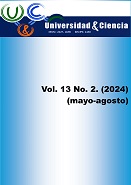Consecuencias sociales de la hipersexualidad, como elementos objetivables, dentro de la industria del porno virtual (Inglés)
DOI:
https://doi.org/10.5281/zenodo.10971006Palavras-chave:
cibersexo, internet, prostitución, sexualidad, sociologíaResumo
La juventud, usualmente, desconoce la madurez y el compromiso del comportamiento que debe tener ante el manejo de las Tecnologías de la Información y Comunicación; especialmente, cuando son precursoras de conductas socialmente inaceptables. Por lo tanto, el objetivo de este estudio es recapacitar acerca de la hipersexualidad como paradigma del entorno virtual y las implicaciones del cibersexo como enfoque; sobre todo, con la adicción a Internet al ser una consecuencia psicosocial del sexo virtual. Entonces, en su búsqueda, se aprovechó a la metodología prisma por ser implicatoria en investigaciones de índole sexual y a una bibliografía actual como medio. Al mismo tiempo, como resultado, se evidenció la existencia de ópticas no divergentes cuando una ‘cover girl’ se convierte en una trabajadora sexual dentro del mundo pornográfico online; mucho peor, si insinúa intimidad forzada y mantiene tapada a su personalidad. Conjuntamente, como otro resultado alcanzado, se demarcó que la industria porno se convierte en la base de la virtualización erótica y la moralidad no sustenta su accionar. Llegando a exponer, como desenlace final, el seguimiento de investigaciones futuras que excluyen paradigmas creados por las aplicaciones digitales, la holografía de la Realidad Aumentada y las Redes Sociales inteligentes 2.0; equiparando al Chat como herramienta de la desnudez cibernética, priorizando la actividad sexual como inicio de una transmisión emocional correcta y que no sea vista como lógica comercial del sadismo porno en línea.
Downloads
Referências
Abel, G. (2023). You're selling a brand: Marketing commercial sex online. Sexualities, 26(3). https://doi.org/10.1177/13634607211056189
Audrezet, A., and Koles, B. (2023). Virtual Influencer as a Brand Avatar in Interactive Marketing. In The Palgrave Handbook of Interactive Marketing. https://doi.org/10.1007/978-3-031-14961-0_16
Begum, H., Abbas, K., Alam, A. S. A. F., Song, H., Chowdhury, M. T., and Abdul Ghani, A. B. (2022). Impact of the COVID-19 pandemic on the environment and socioeconomic viability: a sustainable production chain alternative. Foresight, 24(3–4). https://doi.org/10.1108/FS-02-2021-0053
Bufferd, S. J., Levinson, C. A., Olino, T. M., Dougherty, L. R., Dyson, M. W., Carlson, G. A., and Klein, D. N. (2022). Temperament and psychopathology in early childhood predict body dissatisfaction and eating disorder symptoms in adolescence. Behaviour Research and Therapy, 151. https://doi.org/10.1016/j.brat.2022.104039
Crapolicchio, E., Pecini, C., di Bernardo, G.A., Regalia, C., Andrighetto, L., and Vezzali, L. (2022). Sexting and the experience of non-consensual dissemination of sexts. The moderator role of self-objectification. Social Psychology, 17(2). https://doi.org/10.1482/104810
Döring, N., Krämer, N., Mikhailova, V., Brand, M., Krüger, THC, and Vowe, G. (2021). Sexual Interaction in Digital Contexts and Its Implications for Sexual Health: A Conceptual Analysis. Frontiers in Psychology, 12. https://doi.org/10.3389/fpsyg.2021.769732
Dou, K., Wang, L.X., Li, J. bin, Wang, G.D., Li, Y.Y., and Huang, Y.T. (2020). Mobile phone addiction and risk-taking behavior among Chinese adolescents: A moderated mediation model. International Journal of Environmental Research and Public Health, 17(15). https://doi.org/10.3390/ijerph17155472
FLACSO Official Bulletin (2020). Psychology of sexuality at the adolescent level in Ecuador. In Sexual education for minors, FLACSO, Quito, 3(6), 30-32.
Fulvio, J.M., Ji, M., and Rokers, B. (2021). Variations in visual sensitivity predict motion sickness in virtual reality. Entertainment Computing, 38. https://doi.org/10.1016/j.entcom.2021.100423
Greaves, L. M., Stronge, S., Sibley, C. G., and Barlow, F. K. (2021). Asexual Identity, Personality, and Social Motivations in a New Zealand National Sample. Archives of Sexual Behavior, 50(8). https://doi.org/10.1007/s10508-021-02038-0
Hasan, R., and Hasan, R. (2022). Pedestrian safety using the Internet of Things and sensors: Issues, challenges, and open problems. In Future Generation Computer Systems (134). https://doi.org/10.1016/j.future.2022.03.036
Jacobs, T., Geysemans, B., Hal, G. van, Glazemakers, I., Fog-Poulsen, K., Vermandel, A., Wachter, S. de, and Win, G. de. (2021). Associations between Online Pornography Consumption and Sexual Dysfunction in Young Men: Multivariate Analysis Based on an International Web-Based Survey. JMIR Public Health and Surveillance, 7(10). https://doi.org/10.2196/32542
Janssen, E., Prause, N., Swinburne Romine, R., Raymond, N., MacDonald, A., Coleman, E., and Miner, M. H. (2020). Sexual Responsivity and the Effects of Negative Mood on Sexual Arousal in Hypersexual Men Who Have Sex with Men (MSM). Journal of Sexual Medicine, 17(9). https://doi.org/10.1016/j.jsxm.2020.05.005
Jia, Y., Shao, X., Shen, C., and Wang, W. (2021). Development of a structure-validated hypersexuality scale in Chinese university students. BMC Psychiatry, 21(1). https://doi.org/10.1186/s12888-021-03362-4
Krystek, M., Ciesielski, A., and Samorì, P. (2021). Graphene-Based Cementitious Composites: Toward Next-Generation Construction Technologies. In Advanced Functional Materials, 31(27). https://doi.org/10.1002/adfm.202101887
Lew-Starowicz, M., Lewczuk, K., Nowakowska, I., Kraus, S., and Gola, M. (2020). Compulsive Sexual Behavior and Dysregulation of Emotion. In Sexual Medicine Reviews, 8(2). https://doi.org/10.1016/j.sxmr.2019.10.003
Lewczuk, K., Wójcik, A., and Gola, M. (2022). Increase in the Prevalence of Online Pornography Use: Objective Data Analysis from the Period Between 2004 and 2016 in Poland. Archives of Sexual Behavior, 51(2). https://doi.org/10.1007/s10508-021-02090-w
Limoncin, E., Ciocca, G., Castellini, G., Sansone, A., Cavalieri, F., Cavallo, F., Cocchiaro, T., Ricca, V., di Lorenzo, G., Rossi, A., Fisher, A. D., Rochira, V., Corona, G., and Jannini, E. A. (2022).
Hypersexuality as a tip of the iceberg of a primary psychopathology: a joined position statement of the Italian Society of Andrology and Sexual Medicine (SIAMS) and of the Italian Society of Psychopathology (SOPSI). Journal of Endocrinological Investigation, 45(9). https://doi.org/10.1007/s40618-022-01798-3
Magrath, R., and McCormack, M. (2023). Friendship dynamics of young men with non-exclusive sexual orientations: Group diversity, physical intimacy and emotionality. In Journal of Social and Personal Relationships, 40 (4). https://doi.org/10.1177/02654075221127232
Nguyen, T., Duong, Q. H., Nguyen, T. van, Zhu, Y., and Zhou, L. (2022). Knowledge mapping of digital twin and physical internet in Supply Chain Management: A systematic literature review. International Journal of Production Economics, 244. https://doi.org/10.1016/j.ijpe.2021.108381
Paul, B., Singh, G., Bansal, N., Singh, G., and Paul, G. (2020). Gender Differences in Impulse Control Disorders and Related Behaviors in Patients with Parkinson’s Disease and its Impact on Quality of Life. Annals of Indian Academy of Neurology, 23(5). https://doi.org/10.4103/aian.AIAN_47_20
Pengo, M., Alberici, A., Libri, I., Benussi, A., Gadola, Y., Ashton, N. J., Zetterberg, H., Blennow, K., and Borroni, B. (2022). Sex influences clinical phenotype in frontotemporal dementia. Neurological Sciences, 43(9). https://doi.org/10.1007/s10072-022-06185-7
Petkus, E., and Brown, L. (2019). The Sexually Addicted Couple. In The Disordered Couple. https://doi.org/10.4324/9781351264044-15
Privara, M., and Bob, P. (2023). Sexual development in ADHD and internet pornography consumption. Frontiers in Psychiatry, 14. https://doi.org/10.3389/fpsyt.2023.1240222
Prodhomme, C., Materia, S., Ardilouze, C., White, R. H., Batté, L., Guemas, V., Fragkoulidis, G., and García-Serrano, J. (2022). Seasonal prediction of European summer heatwaves. Climate Dynamics, 58(7-8). https://doi.org/10.1007/s00382-021-05828-3
Swami, V., Hochstöger, S., Kargl, E., and Stieger, S. (2022). Hangry in the field: An experience sampling study on the impact of hunger on anger, irritability, and affect. PLoS ONE, 17(7). https://doi.org/10.1371/journal.pone.0269629
Turner, D., Briken, P., Grubbs, J., Malandain, L., Mestre-Bach, G., Potenza, M. N., and Thibaut, F. (2022). The World Federation of Societies of Biological Psychiatry guidelines on the assessment and pharmacological treatment of compulsive sexual behaviour disorder. Dialogues in Clinical Neuroscience, 24(1). https://doi.org/10.1080/19585969.2022.2134739
UNICEF Official Bulletin (2019). The State of the World’s Children 2019. In Children in a digital world, UNICEF, New York, p. 17-19.
Von Walter, H. (2021). Different Strokes for Impaired Folks: A Medical-Legal Case Report on Psychosis and Grave Disability following Cerebrovascular Accident. The American Journal of Geriatric Psychiatry, 29(4). https://doi.org/10.1016/j.jagp.2021.01.120
Witkiewitz, K., Stein, E. R., Votaw, V. R., Hallgren, K. A., Gibson, B. C., Boness, C. L., Pearson, M. R., and Maisto, S. A. (2022). Constructs Derived from the Addiction Cycle Predict Alcohol Use Disorder Treatment Outcomes and Recovery 3 Years Following Treatment. Psychology of Addictive Behaviors, 37(3). https://doi.org/10.1037/adb0000871
Downloads
Publicado
Como Citar
Edição
Seção
Licença
Copyright (c) 2024 Universidad & ciencia

Este trabalho está licenciado sob uma licença Creative Commons Attribution-NonCommercial-ShareAlike 4.0 International License.





















